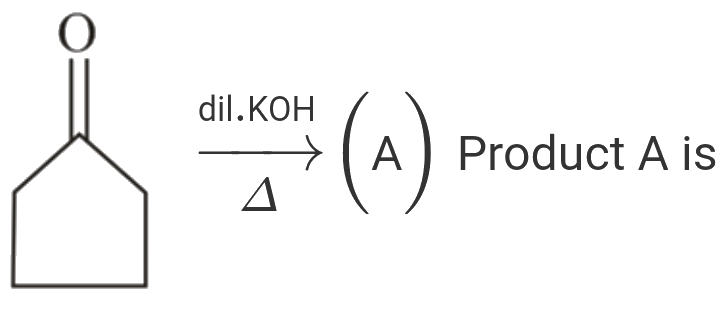PhCONH2(A)−−−→KOBr(B)−−−→MeOH(C)
Product is (C) is :
PhNH2
PhNHCOOMe
PhNHCOOPh
None
The correct Answer is:B
To solve the given question step by step, we will analyze the reactions involved and identify the products formed at each stage.
Step 1: Identify the Starting Material
The starting material (A) is PhCONH2, which is an amide (specifically, benzamide).
Step 2: Reaction with KOBr
The first reaction involves treating benzamide (PhCONH2) with KOBr (potassium bromate). This reaction is known as the Hofmann degradation or Hofmann rearrangement.
In this reaction, the amide undergoes a rearrangement to form an isocyanate intermediate. The general reaction can be represented as:
PhCONH2+KOBr→PhC(=O)N(isocyanate)
Step 3: Formation of Product B
After the rearrangement, the isocyanate can undergo hydrolysis or further reactions. In this case, the isocyanate can react with water or alcohols to form an urea derivative.
Thus, the product (B) after the reaction with KOBr will be:
PhC(=O)N(isocyanate)→PhC(=O)NH(urea)
Step 4: Reaction with MeOH
Now, product (B) reacts with MeOH (methanol). This reaction involves the nucleophilic attack of methanol on the carbonyl carbon of the urea derivative.
The reaction can be represented as:
PhC(=O)NH+MeOH→PhC(=O)OCH_3+NH2
Step 5: Formation of Product C
The final product (C) formed from the reaction of product (B) with MeOH will be:
PhC(=O)OCH_3
This compound is a methyl ester of the corresponding carboxylic acid derived from the urea.
Conclusion
Thus, the final product (C) is:
PhC(=O)OCH_3
Final Answer
The correct option for product (C) is:
PhC(=O)OCH3 (which can also be written as Ph-CO-O-CH3).
---
The starting material (A) is PhCONH2, which is an amide (specifically, benzamide).
The first reaction involves treating benzamide (PhCONH2) with KOBr (potassium bromate). This reaction is known as the Hofmann degradation or Hofmann rearrangement.
PhCONH2+KOBr→PhC(=O)N(isocyanate)
After the rearrangement, the isocyanate can undergo hydrolysis or further reactions. In this case, the isocyanate can react with water or alcohols to form an urea derivative.
PhC(=O)N(isocyanate)→PhC(=O)NH(urea)
Now, product (B) reacts with MeOH (methanol). This reaction involves the nucleophilic attack of methanol on the carbonyl carbon of the urea derivative.
PhC(=O)NH+MeOH→PhC(=O)OCH_3+NH2
The final product (C) formed from the reaction of product (B) with MeOH will be:
PhC(=O)OCH_3
Thus, the final product (C) is:
PhC(=O)OCH_3
The correct option for product (C) is:
PhC(=O)OCH3 (which can also be written as Ph-CO-O-CH3).
Topper's Solved these Questions
- CARBOXYLIC ACIDS AND THEIR DERIVATIVESBook:CENGAGE CHEMISTRY ENGLISHChapter:CARBOXYLIC ACIDS AND THEIR DERIVATIVESExercise:Exercises (Assertion-Reasoning)
Explore 10 Videos
- CARBOXYLIC ACIDS AND THEIR DERIVATIVESBook:CENGAGE CHEMISTRY ENGLISHChapter:CARBOXYLIC ACIDS AND THEIR DERIVATIVESExercise:Exercises Archives (Single Correct)
Explore 10 Videos
- CARBOXYLIC ACIDS AND THEIR DERIVATIVESBook:CENGAGE CHEMISTRY ENGLISHChapter:CARBOXYLIC ACIDS AND THEIR DERIVATIVESExercise:Exercises (Multiple Correct)
Explore 34 Videos
- BIOMOLECULESBook:CENGAGE CHEMISTRY ENGLISHChapter:BIOMOLECULESExercise:Exercises Archives (Analytical And Descriptive)
Explore 8 Videos
- CHEMICAL KINETICSBook:CENGAGE CHEMISTRY ENGLISHChapter:CHEMICAL KINETICSExercise:Archives Subjective
Explore 23 Videos
Similar Questions
Knowledge Check
Succinic acid Δ−−→(A)NH2−−→Δ(B)Br2−−→KOH(C),Product (C) will be :
ACH2−CO2H∣CH2−CH2−NH2BCH2−CO2H∣CH2−NH2CCH2−CO−2K+∣CH2−NH2DCH2−CO2H∣CH2−CH2−Br Br2−−→CCl4(i)alc. KOH−−−−−−−→(ii)NaNH2(A)major, Product (A) is :AH2C=CH−CH=CH2BCH3−C≡C−CH3CCH3−CH2−C≡CHDCH3−CH=C=CH2
Br2−−→CCl4(i)alc. KOH−−−−−−−→(ii)NaNH2(A)major, Product (A) is :AH2C=CH−CH=CH2BCH3−C≡C−CH3CCH3−CH2−C≡CHDCH3−CH=C=CH2Ph−CH2C∣OHH−CH3K−−→C2H2Br−−−−→(A)
Product (A) in above reaction is :APh−CH2−C∣OEtH−CH3 (iversion)BPh−CH2−C∣OEtH−CH3 (retention)CPh−CH2−C∣OEtH−CH3 (racemic)DPh−CH=CH−CH3
In the reaction,
C6H5NH2NaNO2+HCl−−−−−−−−→0−5∘C(A)CuCN−−−→KCN(B)H+/H2O−−−−−→(C)
the product (C) is
View Solution dil.KOH−−−−→Δ(A) Product A is
dil.KOH−−−−→Δ(A) Product A is
View Solution_2019_CBT4_E01_010_Q01.png) KCN−−−→DMSOH2,Pd−−−→ product is
KCN−−−→DMSOH2,Pd−−−→ product is
View SolutionCH3−CH3∣C∣CH3−C∣BrH−CH3El mechanism−−−−−−−−−−→Δ(A)
Major product (A) is
View SolutionCH3−CH3∣C∣OH−CH3Na2Cr2O7−−−−−→cool (P) , product (P) in the reaction is :
View Solution